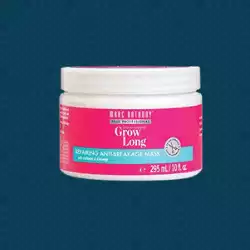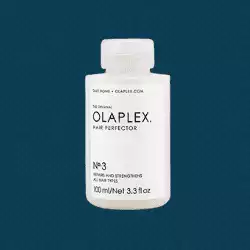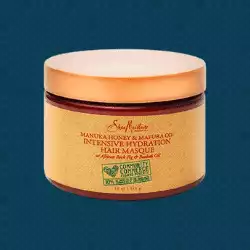Jump to:
Reading this? You’re overdue for a good, nourishing hair mask. Learn how a hair mask can help repair and nourish damaged hair, the pros and cons, and how to make your own hair mask for damaged hair in our quick guide.
Wait, There’s a Hair Mask for Damaged Hair?
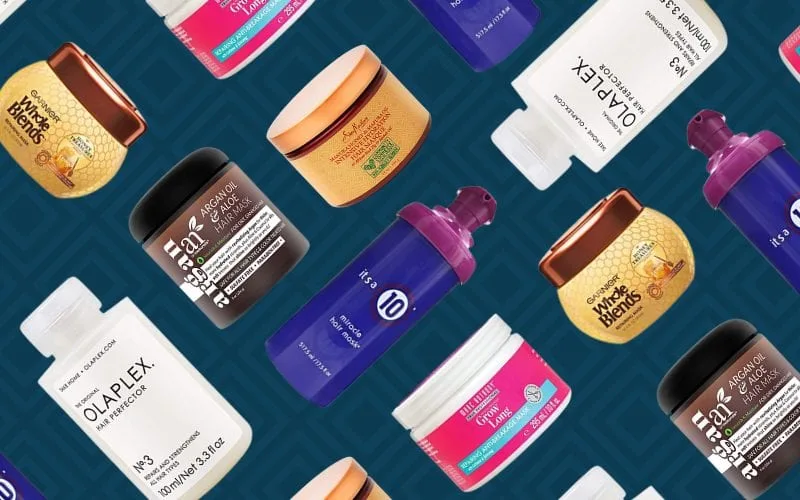
Damaged hair is pretty much a fact of life – most of us are dealing with damage to some extent. Your damage might be from heat styling, chemical processing, rough brushing, tight hairstyles, sun exposure, swimming, excessive shampooing, or a combination of any of these.
But if you think you have to just live with the damage or cut it off, you are blessedly wrong. Those in the know have a little secret for managing, repairing, and moisturizing damaged hair. It’s called a hair mask, and it is impossible to overhype it. They’re that good. But what is a hair mask?
There are several types of hair masks out there. You’ve probably seen a lot of moisturizing masks on the market, and those are great. But for damaged hair, we need something a little different.
Hair masks for damaged hair aren’t necessarily moisturizing masks. Instead, they’re formulated with ingredients that help repair existing damage, smooth out the texture of strands, and fuse split ends for a healthier, thicker look.
If you want to start using a hair mask for damaged hair, don’t rush into it. There are some excellent options out there, but a few can wreak havoc on already damaged strands.
Read through our quick guide to learn all about hair masks for damaged hair: The benefits, downsides, things to consider, and how to make your very own DIY hair mask. Get ready to love on your hair with a healthy, damage-repairing mask!
What Is a Hair Mask for Damaged Hair?
You’ve no doubt heard of moisturizing hair masks, but you might not be familiar with the damage-repairing variety.
These thick formulas are made to sit on the hair for a period of time – anywhere from 20 minutes to overnight – to allow the ingredients sufficient time to make contact with your hair and penetrate deep into strands. These treatments need a little time to work their magic.
They typically contain ingredients beyond the typical moisturizing and sealing ingredients like water, humectants, oils, and butters. Since moisture alone won’t repair damage, hair masks for damaged hair have additional ingredients that target both visible and invisible signs of damage.
You’ll find protein and amino acid-based ingredients in damage-repairing masks. Since hair is mostly made of protein (specifically keratin), physical damage to hair strands can only be repaired when protein is available to fill in gaps in the hair structure.
Reparative hair masks provide a way to get amino acids and protein into the areas it’s needed in damaged hair. That might be split ends, gaps in the outermost layer (the cuticle layer), or any rough areas along the hair shaft.
After using a hair mask for damaged hair, you will notice that your hair feels healthier, softer, and smoother with less breakage.
Read Next: How Often Should You Do a Hair Mask?
Hair Mask Benefits for Damaged Hair
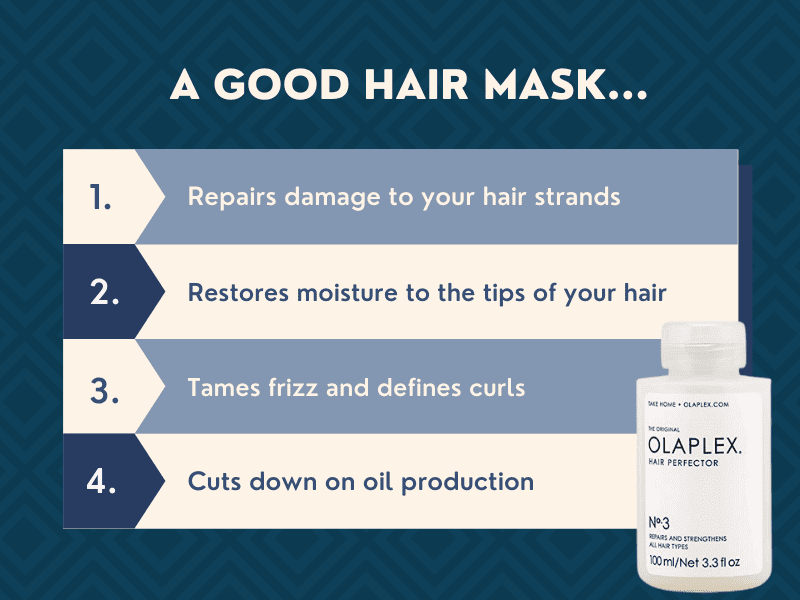
Damaged hair can really benefit from a reparative mask. Here are the most notable benefits of using a protein mask for damaged hair.
Smoothes Strands
Protein acts like a spackle for porous or damaged areas of your hair strands. So if your hair looked like a road with potholes under a microscope due to years of damage, using a protein mask regularly will smooth out those pothole areas and give you smoother strands as a result.
Reduces Frizz
A thin coating of protein on hair strands helps keep your hair from absorbing too much water and swelling (the root cause of frizz). With the regular use of a mask containing damage-repairing protein, your hair will get the right amount of moisture and won’t frizz up.
Fuses Split Ends
When protein is applied to hair with split ends (a common result of hair damage), it won’t technically eliminate them, but it can fuse them together and make them less obvious. Split ends are one of the tell-tale signs of damage, so using a damage-repairing mask containing protein will help you temporarily “erase” your split ends without getting a trim.
Reduces Breakage and Strengthens Hair
Hair is made of keratin, a type of protein. When hair is damaged, areas of the hair shaft can become weakened to the point of breakage. You might notice breakage close to the roots or further along the hair shaft. Using a protein-based hair mask will strengthen and fortify those weakened areas and reduce the amount of breakage you experience.
Read Next: What Is a Keratin Treatment?
The Downside of Hair Masks
While the benefits hair masks offer are great, they’re not a miracle worker for everyone with damaged hair. There are really only two possible downsides to using a damage-repairing hair mask: Protein overload and excessive oiliness or product buildup.
The first possible downside is the potential for protein overload if you have low porosity hair. Low porosity hair has a tightly closed cuticle layer (the outermost layer of hair) and doesn’t easily allow products or water to penetrate.
When you use a mask containing any type of protein on low porosity hair, the protein can’t make its way into the hair and builds up on the outside of strands. The result is hair that feels stiff and straw-like, breaks off easily, and may experience changes in hair texture and curls.
Do a Test
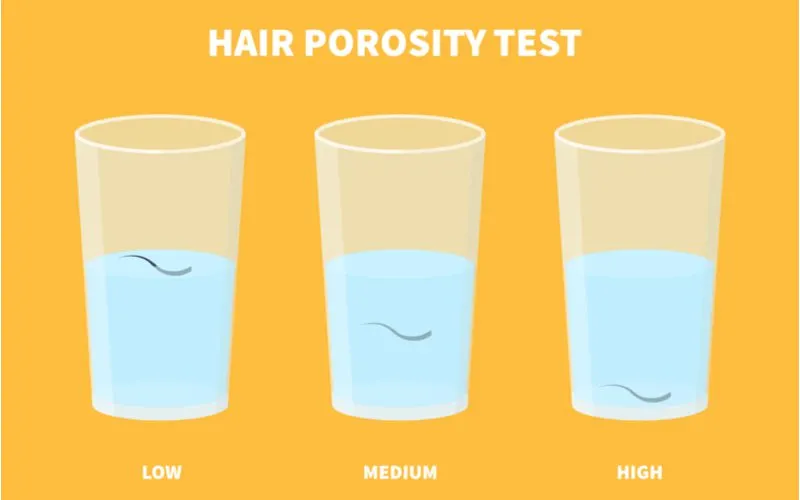
art4stock/Shutterstock
You can check your hair’s porosity by plucking one strand and putting it into a glass of water. If it’s floating after 2 minutes, it’s likely low porosity hair. If it’s sunk to the middle, it’s medium porosity, and if it’s at the bottom, it’s high porosity hair.
The second downside is the potential to cause excessive oiliness or buildup in the hair. If you choose a damage-repairing hair mask that is too heavy for the thickness of your strands, the moisturizing ingredients in the formula will coat your hair and weigh it down.
If you’ve picked a mask that’s too heavy and you have fine or medium thick hair strands, you may notice that your roots appear oily quickly, and your hair feels and looks limp.
A too-heavy mask may also be harder to wash out fully, making buildup a common issue. Hair with mask buildup left behind will appear dirty, harder to style, and limp without volume.
You can avoid these issues by ensuring you don’t apply a damage-repairing mask to low porosity hair and choosing a mask with ingredients suitable for your hair texture and type – or just make your own mask.
Now let’s take a look at the best options you have when using a mask like this for damaged hair. You can buy one or make it yourself with a few simple ingredients.
How to Make Your Own Hair Mask for Damaged Hair
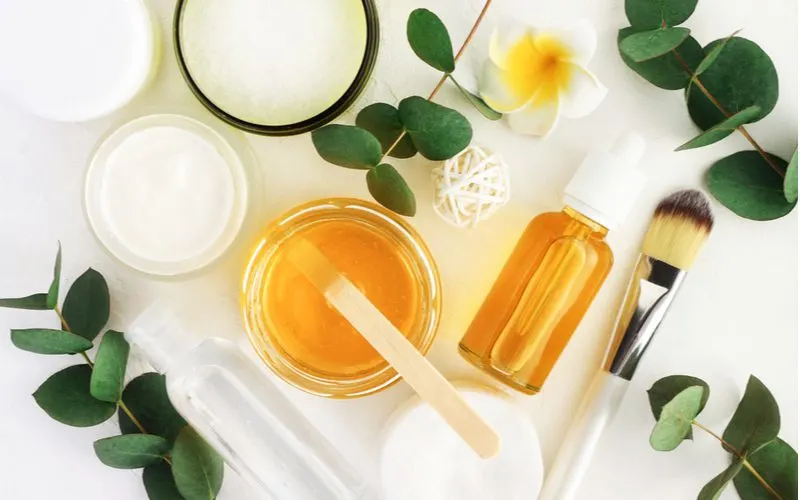
Anna ok/Shutterstock
Making your own hair mask for damaged hair is so easy and inexpensive, and a quick Google search for recipes brings up a ton of results. Unfortunately, there are thousands of DIY hair mask recipes online that won’t do a thing for damaged hair in need of protein. You need a “secret ingredient” that most DIY masks skip.
You’ll see several protein packs and masks containing yummy ingredients like yogurt, milk, honey, avocado, and eggs, but the proteins in these items are too big to penetrate the hair shaft. Hydrolyzed protein, on the other hand, is small enough to penetrate the hair and repair damage. That’s what you need.
You can buy a good-sized bottle of hydrolyzed keratin (the protein in hair) for your DIY hair mask. This ensures the protein in your mask is small enough to enter your hair strands and actually get to work repairing damage.
Here’s a great, low-cost option that contains enough protein to make several batches of your homemade hair mask: Hydrolyzed Keratin Protein (30 ml).
DIY Hydrolyzed Protein Hair Mask
Making your own hair mask with hydrolyzed protein for your hair can actually use is super simple. Here’s all you need.
Ingredients and Supplies
- 1-2 tablespoons hydrolyzed protein (we recommend keratin)
- 1-2 cups of your favorite conditioner (depending on hair length)
- Small bowl
- Shower cap
Directions
- Mix the liquid hydrolyzed protein in with your favorite conditioner in a small bowl.
- Wet your hair thoroughly, apply the mixture all over, or concentrate on the most damaged areas.
- Cover with a plastic shower cap.
- Allow the mask to sit on your hair for at least an hour, but preferably overnight. The longer you can leave it on, the better your results will be.
- When you’re ready, remove the cap and thoroughly rinse it out. Follow up with shampoo to avoid leaving buildup on your hair.
Since you’ll be using a conditioner you’re already familiar with, you can be sure this mask won’t overwhelm your hair texture and make it greasy, limp, or weighed down with product.
3 Damage-Repairing Hair Masks to Try
For Dry Hair
- Sulfate-free.
- Inexpensive product.
- Hydrates, controls frizz, and nourishes hair.
- Long ingredient label with synthetic ingredients.
- Not ideal for thin hair.
Chronically dry hair can really benefit from a moisturizing + damage repairing mask like the Marc Anthony Grow Long Hair Mask. This hydrating option will coat your hair in nourishing seed oils, plant extracts, and natural oils to deliver intense moisture deep into strands.
But hydrolyzed keratin is the star of the show since it is able to fill in gaps in the hair structure and smooth over rough areas for shiny, soft results. This formula is designed to encourage better and healthier hair growth, so it also contains scalp-stimulating caffeine, biotin, and broken-down amino acids.
If you are growing out your hair or just want to see fast, healthy growth along with damage repair, this is the hair mask for you!
For Fine or Oily Hair
If other hair masks prove too heavy for your fine or oil-prone hair, Olaplex Hair Perfector No. 3 Repairing Treatment is the best thing for it. This damage-repairing treatment isn’t quite a mask because it offers no real hydration benefits, but it will get right to work smoothing and repairing the rough areas of your hair.
This treatment contains hydrolyzed soy and wheat proteins and wheat amino acids to strengthen and smooth damaged areas. Nourishing seed oils and vitamins are also in the mix to ensure your hair gets all the nutrients it needs.
Use it once a week if you have light to moderate hair damage, or up to 3 times a week for serious damage. Apply it to damp hair, from scalp to ends, and leave it for about 20 minutes for best results.
For Coarse or Coily Hair
Coarse and coily hair tends to be thicker (denser), frizzy, and almost impossible to over-moisturize. If that sounds like your hair, grab SheaMoisture Intensive Hydration Masque.
This heavyweight champion of hair masks offers deep hydration along with damage-repairing hydrolyzed rice protein, so you get the best of both worlds. It contains nourishing natural ingredients like seed oils and butters, figs, honey, and avocado so your hair can thrive.
Since this is a heavier hair mask, you only need to leave it on for about 5 minutes. You can improve your results by applying heat while the mask is on your hair. Use it once a week or up to 3 times a week if your hair is in desperate need of moisture.
Things to Consider
If your hair is at all damaged, you definitely need to start working to repair that damage with the help of hydrolyzed protein. You can do it by adding protein-fortified shampoo, conditioner, or other hair products to your routine, but hair masks are one of our favorite ways to incorporate this type of protein.
That’s because hair masks put you in control – you decide when to use them, how often, and how long to leave them on. You can even mix up your own DIY damage-repairing hair mask to customize the ingredients for your hair’s specific needs.
Just keep the possible downsides in mind before you buy, make, or try a protein hair mask.
- Avoid protein masks altogether if you have low porosity hair, and opt for gentle, moisturizing hair masks instead. Protein overload can occur on low porosity hair when protein is applied.
- If you have very fine hair or hair that gets oily fast, some masks won’t work for you. Opt for a non-moisturizing protein mask or treatment like Olaplex Hair Perfector No. 3 instead of a heavy, hard-to-rinse moisturizing mask.
- If you have coarse or coily hair, look for a mask that combines protein (for damage repair) with heavy hydration in the form of humectants like honey, aloe vera, and glycerine. Even better if it contains sealing oils to lock all that moisture in! SheaMoisture’s Intensive Hydration Masque is perfect for this hair type.
So, What’s the Best Hair Mask for Damaged Hair?
Now that you’re a verifiable expert on hair masks for damaged hair, you have the option to buy a mask that meets your hair’s needs or mix up your own. If you decide to go the DIY route, don’t be afraid to experiment with ingredients!
Try making your own concoction with ingredients you may already have on hand. Just make sure you don’t skip the hydrolyzed keratin – that’s the secret ingredient to make homemade hair masks effective for damage repair.

